When it comes to motorcycling, no two words are more synonymous with hooligan-like behavior than “Speed” followed by “Triple.” For almost two decades, Triumph’s raw, naked and all-together spritely Speed Triple has redefined the boundaries between standard and sport-type motorcycles. Its three-cylinder engine is seemingly the best combination of torque and horsepower — especially for a street-oriented machine — and it doesn’t hurt that it’s filled to the brim with character.
What has set the Speed Triple apart all these years is its styling — or rather, lack thereof. Its naked stance has been the major draw to this bike since day one, and since a naked bike doesn’t have many distinguishable features by nature, the Speed Triple stood out because of one instantly recognizable trait: its round headlights.
Well, those lights are gone now, replaced by more angular units. But the lights are just a small part of an overall whole that’s radically different, yet still largely based on the same basic motorcycle. Allow us to explain.
A New Take on an Old Classic
Triumph engineers left no stone unturned when redesigning the Speed Triple. To keep things simple there were three goals to adhere to: it had to be lighter, it had to have more useable power (not that it was lacking in this department), and the last one is a bit strange: it had to feel more like its younger brother, the Street Triple.
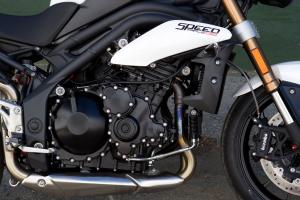 To obtain the first objective, the entire chassis was redesigned to package the bike’s vital components closer together and with a greater forward weight bias. The new frame is slightly lighter than the one it replaces, though the major weight savings comes from all-new wheels and wheel assemblies that, combined, are more than six pounds lighter than last year. This despite the new model’s rear wheel being widened to six-inches (from 5.5-inches) to better accommodate a 190-series tire, and a single-sided swingarm that’s 18.5mm longer yet 2.2 pounds lighter than before.
To obtain the first objective, the entire chassis was redesigned to package the bike’s vital components closer together and with a greater forward weight bias. The new frame is slightly lighter than the one it replaces, though the major weight savings comes from all-new wheels and wheel assemblies that, combined, are more than six pounds lighter than last year. This despite the new model’s rear wheel being widened to six-inches (from 5.5-inches) to better accommodate a 190-series tire, and a single-sided swingarm that’s 18.5mm longer yet 2.2 pounds lighter than before. This revised chassis was also a measure to place more weight toward the front tire. Its engine is placed forward 3mm and tilted forward seven degrees to shift more weight to the front.
Other than the lengthened swingarm, further measures include moving the battery in front of the fuel tank and steepening the steering head angle. Triumph also moved the most dynamic piece of the puzzle closer forward as well — the rider. But I’ll get into that a little later. All told, the 2011 Speed Triple places 50.9% of the vehicle’s weight over the front, compared to 48.6% for the 2010 model.
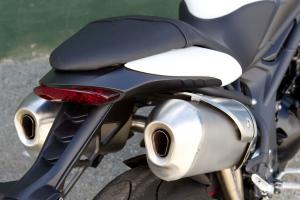 The Speed Triple retains the same basic 1050cc three-cylinder engine from last year, but with a few little tweaks that allow the bike to breathe a little easier. A revised airbox now has a 10% greater filter area, while revised fuel-injection software is claimed to improve fuel economy by 6%. A new sump allows for closer packaging of the exhausts and provides more ground clearance as well.
The Speed Triple retains the same basic 1050cc three-cylinder engine from last year, but with a few little tweaks that allow the bike to breathe a little easier. A revised airbox now has a 10% greater filter area, while revised fuel-injection software is claimed to improve fuel economy by 6%. A new sump allows for closer packaging of the exhausts and provides more ground clearance as well. Header pipe diameter is reduced to 38mm (from 42mm), and secondary exhaust pipes are enlarged to 50.8mm (from 44.5mm), all for “more useable power.” Inside the engine, the inner cylinder transfer holes have been opened to reduce pumping losses during the pistons’ downward stroke. All told, Triumph claims a five horsepower increase (to 133 hp) and 8% more torque (82 ft.-lb.) compared to its predecessor. A new, high-efficiency radiator helps keep engine temps under control.
Triumph showed us a dyno chart comparison with this year’s engine overlaid on the previous version. What’s interesting is that below 4800 rpm the old engine actually made more power and torque. It’s not until that threshold is crossed does the new lump out-pull for the rest of the rev range. A clear demonstration of more useable power.
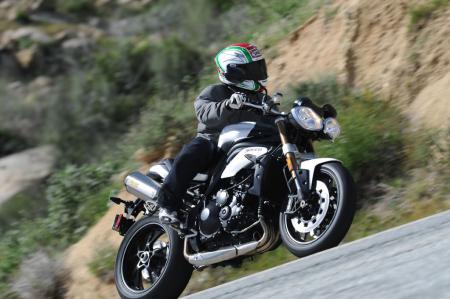 Triumph set out to make the new Speed Triple feel more compact like the Street Triple. Mission accomplished. Triumph set out to make the new Speed Triple feel more compact like the Street Triple. Mission accomplished. |
I found it odd that Triumph focused its attention on making the new Speed Triple feel more like the Street Triple. The size or rider position of the old model never struck me as something that needed revising, but in transforming this machine for 2011, the shop in Hinckley combed over every detail.
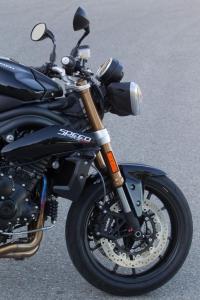 Steering geometry has been tweaked as well, again to put the focus on the front end. Rake has been sharpened to 22.8 degrees (from 23.5) for quicker response, while trail has increased to 3.6 inches (from 3.3). Wheelbase has also grown slightly to 56.5 inches (from 56.1), in an effort to help aid stability.
Steering geometry has been tweaked as well, again to put the focus on the front end. Rake has been sharpened to 22.8 degrees (from 23.5) for quicker response, while trail has increased to 3.6 inches (from 3.3). Wheelbase has also grown slightly to 56.5 inches (from 56.1), in an effort to help aid stability. Beyond that, the overall bike feels more compact than before thanks to a few small but noticeable changes. The forward tilt of the engine and the relocated battery allowed engineers to move the rider closer to the bars. Seat height is now at 32.5 inches, 0.2-inch lower than before. The front wheel axle to the forward-most edge of the saddle is now reduced from last year by almost two inches (1.7 to be exact), and the bars are repositioned one inch closer to the rider. Footpegs, too, are moved forward by over an inch (1.14 inches) to complete the revised rider triangle.
Time to Act Like a Hooligan
Okay, maybe not. But just by sitting on the new Speed Triple I could immediately tell everything was more compact. I’d call it close to Street Triple territory, but there’s no hiding the fact that the bigger engine is physically, well, bigger. Besides the engine tilting slightly forward, the rider is placed at a forward slant as well, but just barely. It’s definitely a comfortable machine with ergonomics suitable for a long journey.
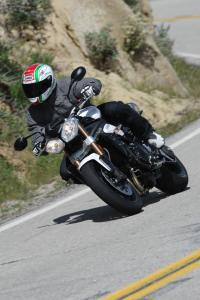 Which is convenient because that’s exactly what Triumph had in store during the North American introduction of both it and the new 675R (which we’ll cover in a separate story). Our two-day journey would start us off in Idyllwild, Calif., and snake its way through roads less traveled, eventually leading to our stop in Indio at the end of our first day. Day two would be spent at Southern California’s newest racetrack, Chuckwalla Valley Raceway, where we put it and the 675R through their paces.
Which is convenient because that’s exactly what Triumph had in store during the North American introduction of both it and the new 675R (which we’ll cover in a separate story). Our two-day journey would start us off in Idyllwild, Calif., and snake its way through roads less traveled, eventually leading to our stop in Indio at the end of our first day. Day two would be spent at Southern California’s newest racetrack, Chuckwalla Valley Raceway, where we put it and the 675R through their paces.Even though the Speed Triple is all-new this year, there’s an instant familiarity while riding it that comes from the amount of seat time I’ve spent on the previous model. Despite the new ergonomics, I instantly felt right at home.
Power was never something we complained about in the previous model, but we’re sure happy there’s more of it this time around. As promised, it didn’t take long for the melodic three-cylinder to steal the show. On the street there’s seemingly instant power, thanks to the broad, flat torque curve throughout the rev range.
Fueling, especially at slow speeds, is crisp with hardly any hesitation. Unfortunately, our street ride was littered with four-wheeled traffic that prevented us from thoroughly flogging the bike, but this was an opportunity to demonstrate the massive torque available; at 40 mph and lugging along in sixth gear, a simple whack of the throttle was met with an initial burble before unleashing brute force that easily carried me into the triple-digit mark. There was still plenty of power left to spare, but self-preservation instincts (and a desire to keep my license) forced me to let off early.
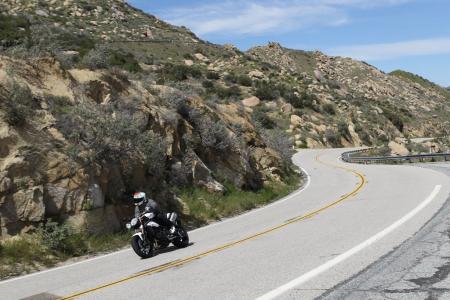 With so much torque on tap, I don’t remember shifting out of third gear through this entire stretch of road. With so much torque on tap, I don’t remember shifting out of third gear through this entire stretch of road. |
That doesn’t mean we weren’t able to take advantage of the new chassis, however. Anyone familiar with these roads will know that there’s a diverse mix of slow corners and wide, sweeping turns along the route, and the Speed Triple was impressive in both areas. The handlebars provide plenty of leverage to get the bike to flick, but that really wasn’t necessary since the steep rake angle helps it turn quickly anyway. According to Triumph, the lighter wheels help reduce steering inertia by 5%.
Once on its side, the S3 is completely comfortable staying there. Here, the longer trail and wheelbase definitely plays a part. It’s dead easy to hold a line with maintenance throttle, but minor changes in trajectory are possible as well. Triumph wasn’t quick to mention it, but a 43mm inverted Showa fork and accompanying Showa monoshock are also tweaked this year with damping rates more suited toward the many bumps and imperfections faced during street riding. Both units are fully-adjustable for preload, rebound and compression damping, and the suspension formed a good balance between absorbing bumps yet still providing a firm ride.
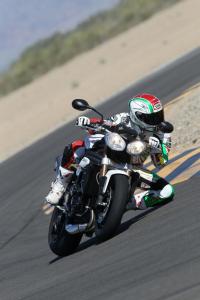 Stopping also has never been an issue on previous models, but here again the new S3 sees some minor changes to the braking system. Basically, the 320mm rotors are now 0.5mm thinner than before to dissipate heat quicker. Four-piston Brembo calipers (not of the monobloc variety) provide the squeeze, while a Brembo master cylinder feeds the fluid. If you’ve seen videos on Youtube of stunt riders doing crazy endo maneuvers on the old Speed Triple, you’ll understand how strong they are. These are no different. Stopping power is still ridiculous, with plenty of feel at the lever.
Stopping also has never been an issue on previous models, but here again the new S3 sees some minor changes to the braking system. Basically, the 320mm rotors are now 0.5mm thinner than before to dissipate heat quicker. Four-piston Brembo calipers (not of the monobloc variety) provide the squeeze, while a Brembo master cylinder feeds the fluid. If you’ve seen videos on Youtube of stunt riders doing crazy endo maneuvers on the old Speed Triple, you’ll understand how strong they are. These are no different. Stopping power is still ridiculous, with plenty of feel at the lever. The Speed Triple is also available with optional ABS, which is a first. While I did have a chance to ride the one model equipped with such, I wasn’t aware of it and didn’t have the opportunity to test its functionality due to the traffic conditions. We’ll have to save our thoughts about the system for a future test.
Due to the traffic we experienced at the later stages of our ride, I was pleasantly surprised at the Speed Triple’s comfortable saddle when lollygagging around town (or stuck behind a train of cars). There’s padding in the right places and it’s just firm enough to provide support without feeling like a plank.
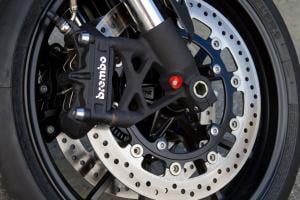 Though it has minimal bodywork, the side panels and radiator shrouds are pretty impressive in channeling heat away from the rider. Speaking of styling, it’s hard to mistake the new model as anything other than a Speed Triple, yet the iconic dual round headlights give way to angular, shaped lights. Why the change? Because Triumph felt the need to change with the times, and that included changing the headlights to projector beam-style units, despite objections from traditionalists.
Though it has minimal bodywork, the side panels and radiator shrouds are pretty impressive in channeling heat away from the rider. Speaking of styling, it’s hard to mistake the new model as anything other than a Speed Triple, yet the iconic dual round headlights give way to angular, shaped lights. Why the change? Because Triumph felt the need to change with the times, and that included changing the headlights to projector beam-style units, despite objections from traditionalists. The new headlights got me thinking: What if Triumph wrapped a full fairing over them, gave the bike proper suspension, and most importantly, bumped the engine displacement to 1100cc. Then we’d have a true liter-class sportbike from Hinckley. And with World Superbike rules allowing 1000cc Fours and 1200cc Twins, the 1100cc Triple would be a perfect fit. Who knows if it’ll actually happen, but it’s a nice thought, right?
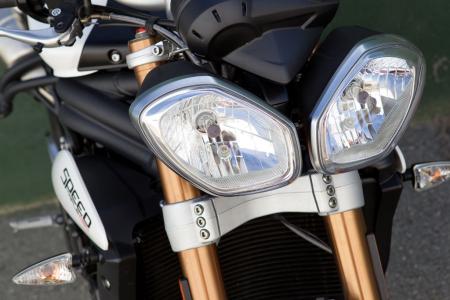 Goodbye iconic round headlights, hello... whatever this is. All good things must come to an end, and the time had come for Triumph to bring the Speed Triple up-to-date in the headlight department. Goodbye iconic round headlights, hello... whatever this is. All good things must come to an end, and the time had come for Triumph to bring the Speed Triple up-to-date in the headlight department. |
What’s it Doing at the Track?
Taking the Speed Triple for a spin on the racetrack would reveal its performance at the limit. It was comically surprising how much fun it was to ride around the tight Chuckwalla track. With all the torque on tap, it’s entirely possible to keep the bike in third gear for the entire length of the track and never worry about shifting. It’s got that much grunt. The six-speed transmission is smooth both on and off the track, and the quick handling we noticed on the street transferred over as well.
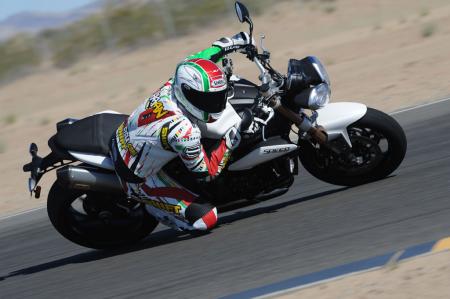 While it’s definitely not made for the track, it can still get around one at a good clip. Ultimately, ground clearance is the limiting factor. While it’s definitely not made for the track, it can still get around one at a good clip. Ultimately, ground clearance is the limiting factor. |
The street-biased suspension made for a plush ride, and yet handled track duties surprisingly well. But make no mistake, race suspension it most definitely is not. Braking, too, was equally as powerful on the track as it was on the street and didn’t show any signs of fading. The only limitation is ground clearance, as the footpegs tend to scrape the tarmac at knee-dragging lean angles.
A full day of lapping around Chuckwalla further fueled my imagination into dreaming up a Triumph literbike. The bike is so entertaining to ride around the track as it is. A proper variant made to handle that kind of abuse would just be icing on the cake.
Ready to Lose Your License?
In case it wasn’t clear already, the Speed Triple is a hit. Always has been. With a potent engine, capable chassis, strong brakes and comfortable riding position, what’s not to like? The redesign will make some people angry — I admit I prefer the round headlights — but even the most iconic styles need a makeover now and then.
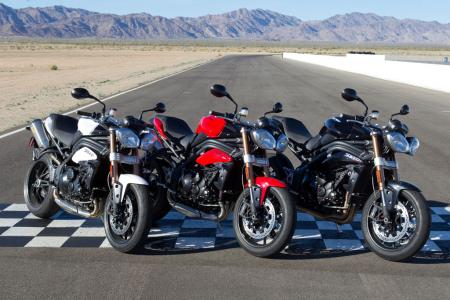 Pick your poison; the Speed Triple will be available in three colors: Crystal White, Diablo Red, or Phantom Black. Pick your poison; the Speed Triple will be available in three colors: Crystal White, Diablo Red, or Phantom Black. |
That’s not to say the Speed Triple isn’t without its shortfalls, although the list is admittedly small. Our ride didn’t include any freeway time, but judging from past experience, a windscreen will be a desired item at anything over 75 mph. Fortunately, that’s a genuine Triumph accessory available specifically for the Speed Triple, and according to Triumph, it’s the best-selling accessory in the catalog.
Other accessory items include a tire-pressure-monitoring system, Arrow Low Boy and slip-on exhausts (which Triumph claims cuts up to 50% of the weight of the standard exhaust system), seat cowl, belly pan, bar-end mirrors, anodized aluminum reservoirs, a lower seat, pre-formed luggage and the aforementioned fly screen, all of which come with a two-year warranty. (Perhaps they should come up with a round-headlight option… –Ed.)
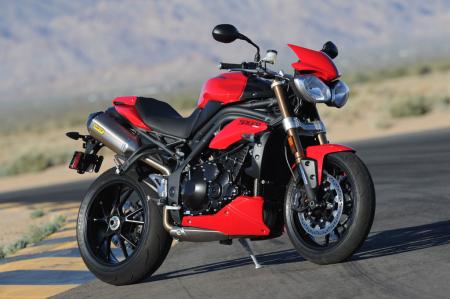 This is just a mild example of what could happen if you rifled through the accessories catalog. This is just a mild example of what could happen if you rifled through the accessories catalog. |
I think it’s safe to say, the king of the hooligan bikes is back and better than ever. But then again, it’s not like it went anywhere. Speed Triples should be in dealers before the summer and will be available for $11,799. Add $800 for the ABS option.



 9:57 PM
9:57 PM
 Unknown
Unknown


 Posted in:
Posted in: 



0 comments:
Post a Comment